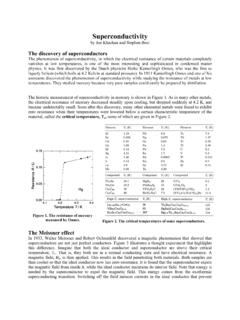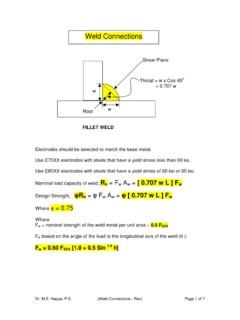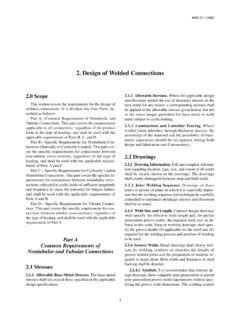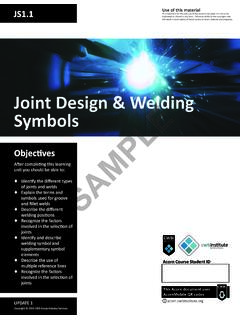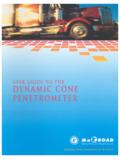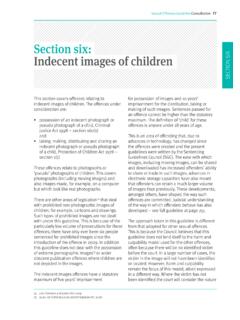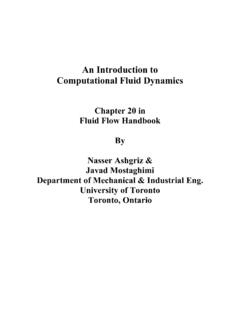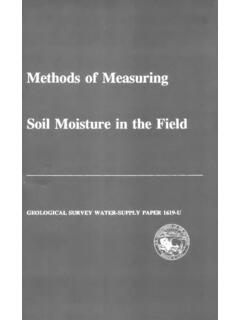Transcription of GUIDE TO CONE PENETRATION TESTING
1 Cone Bearing (bar), Qt11010010000 1 2 3 4 5 6 7 8 Friction Ratio (%), Rf123111245678910 ZONE Qt/N SBT1 2 Sensitive, fine grained2 1 Organic materials3 1 Clay4 Silty clay to clay5 2 Clayey silt to silty clay6 Sandy silt to clayey silt7 3 Silty sand to sandy silt8 4 Sand to silty sand9 5 Sand10 6 Gravelly
2 Sand to sand11 1 Very stiff fine grained* 12 2 Sand to clayey sand**over consolidated or cementedSoil Behavior Type (SBT)Remember:NOT the same assoil classificationGet CPT resultsto client!!Meeting TO CONE PENETRATION TESTING6th Edition 2015 GUIDE toCone PENETRATION TestingforGeotechnical EngineeringByP. K. Cabal (Robertson)Gregg Drilling & TESTING , 2014 Gregg Drilling & TESTING , Headquarters2726 Walnut AvenueSignal Hill, California 90755 Telephone: (562) 427-6899 Fax:(562) publisher and the author make no warranties or representations of any kind concerning the accuracy orsuitability of the information contained in this GUIDE for any purpose and cannot accept any legalresponsibility for any errors or omissions that may have been 2014 Gregg Drilling & TESTING , Inc.
3 All rights OF CONTENTSG lossaryiIntroduction1 Risk Based Site Characterization2 Role of the CPT3 Cone PENETRATION Test (CPT) 6 Introduction6 History7 Test Equipment and Procedures10 Additional Sensors/Modules11 Pushing Equipment12 Depth of Penetration17 Test Procedures17 Cone Design20 CPT Interpretation24 Soil Profiling and Soil Type25 Equivalent SPT N60 Profiles33 Soil Unit Weight ( )36 Undrained Shear Strength (su)37 Soil Sensitivity38 Undrained Shear Strength Ratio (su/ 'vo)39 Stress History - Overconsolidation Ratio (OCR)40In-Situ Stress Ratio (Ko) 41 Relative Density (Dr)42 State Parameter ( )44 Friction Angle ( )46 Stiffness and Modulus48 Modulus from Shear Wave Velocity49 Estimating Shear Wave Velocity from CPT50 Identification of Unusual Soils Using the SCPT51 Hydraulic Conductivity (k)
4 52 Consolidation Characteristics55 Constrained Modulus58 Applications of CPT Results59 Shallow Foundation Design60 Deep Foundation Design 83 Seismic Design - Liquefaction96 Ground Improvement Compaction Control121 Design of Wick or Sand Drains124 Software125 Main References129 CPT GUIDE 2014 GlossaryiGlossaryThis glossary contains the most commonly used terms related to CPT and arepresented in alphabetical PENETRATION PENETRATION test with pore pressure measurement part of the cone penetrometer on which the cone resistance penetrometerThe assembly containing the cone, friction sleeve, and any othersensors, as well as the connections to the push resistance, qcThe force acting on the cone, Qc, divided by the projected area of thecone, Qc/ AcCorrected cone resistance, qtThe cone resistance qccorrected for pore water qc+ u2(1- a)
5 Data acquisition systemThe system used to record the measurements made by the testA test when the decay of the pore pressure is monitored during a pausein elementThe porous element inserted into the cone penetrometer to allowtransmission of pore water pressure to the pore pressure sensor, whilemaintaining the correct dimensions of the cone ratio, RfThe ratio, expressed as a percentage, of the sleeve friction resistance,fs, to the cone resistance, qt, both measured at the same (fs/qt) x 100%CPT GUIDE - 2014 GlossaryiiFriction reducerA local enlargement on the push rods placed a short distance above thecone penetrometer, to reduce the friction on the push sleeveThe section of the cone penetrometer upon which the frictionresistance is cone resistance, QtThe cone resistance expressed in a non-dimensional form and takingaccount of the in-situ vertical (qt vo) / 'voNormalized cone resistance, QtnThe cone resistance expressed in a non-dimensional form takingaccount of the in-situ vertical stresses and where the stress exponent(n) varies with soil type and stress level.
6 When n = 1, Qtn= 'q2t Net cone resistance, qnThe corrected cone resistance minus the vertical total qt voExcess pore pressure (or net pore pressure), uThe measured pore pressure less the in-situ equilibrium pore pressure. u = u2 u0 Pore pressureThe pore pressure generated during cone PENETRATION and measured bya pore pressure sensor:u1when measured on the cone faceu2when measured just behind the pressure ratio, BqThe net pore pressure normalized with respect to the net u / qnPush rodsThick-walled tubes used to advance the cone penetrometerSleeve friction resistance, fsThe frictional force acting on the friction sleeve, Fs, divided by itssurface area, Fs/ AsCPT GUIDE 2014 Introduction1 IntroductionThe purpose of this GUIDE is to provide a concise resource for the applicationof the CPT to geotechnical engineering practice.
7 This GUIDE is a supplementand update to the book CPT in Geotechnical Practice by Lunne, Robertsonand Powell (1997). This GUIDE is applicable primarily to data obtained usinga standard electronic cone with a 60-degree apex angle and either a diameterof mm or mm (10 or 15 cm2cross-sectional area).Recommendations are provided on applications of CPT data for soilprofiling, material identification and evaluation of geotechnical parametersand design. The companion book (Lunne et al., 1997) provides more detailson the history of the CPT, equipment, specification and performance. Acompanion GUIDE to CPT for Geo-environmental Applications is companion book also provides extensive background for the application of the CPT for geotechnical designA list of the main references is included at the end of this GUIDE .
8 A morecomprehensive reference list can be found in the companion CPT book andthe recently listed technical papers. Some recent technical papers can bedownloaded from , details on CPT interpretation are provided in a series of freewebinars that can be viewed Acopy of the webinar slides can also be downloaded from the same web GUIDE - 2014 Risk Based Site Characterization2 Risk Based Site CharacterizationRisk and uncertainty are characteristics of the ground and are never fullyeliminated. The appropriate level of sophistication for site characterizationand analyses should be based on the following criteria: Precedent and local experience Design objectives Level of geotechnical risk Potential cost savingsThe evaluation of geotechnical risk is dependent on hazards, probability ofoccurrence and the can be classified as either: low,moderate or high risk, depending on the above criteria.
9 Table 1 shows ageneralized flow chart to illustrate the likely geotechnical groundinvestigation approach associated with risk. The level of sophistication in asite investigation is also a function of the project design objectives and thepotential for cost 1 Risk-based flowchart for site characterizationCPT GUIDE - 2014 Role of the CPT3 Role of the CPTThe objectives of any subsurface investigation are to determine the following: Nature and sequence of the subsurface strata (geologic regime) Groundwater conditions (hydrologic regime) Physical and mechanical properties of the subsurface strataFor geo-environmental site investigations where contaminants are possible, theabove objectives have the additional requirement to determine.
10 Distribution and composition of contaminantsThe above requirements are a function of the proposed project and theassociated risks. An ideal investigation program should include a mix of fieldand laboratory tests depending on the risk of the 2 presents a partial list of the major in-situ tests and their perceivedapplicability for use in different ground applicability and usefulness of in-situ tests(Lunne, Robertson & Powell, 1997, updated by Robertson, 2012)CPT GUIDE - 2014 Role of the CPT4 The Cone PENETRATION Test (CPT) and its enhanced versions such as thepiezocone (CPTu) and seismic (SCPT), have extensive applications in a widerange of soils.
